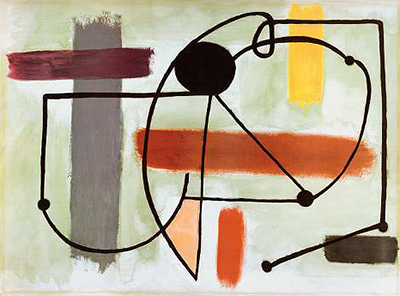Much like many of his other works, Torso is partially defined by its use of bold and sometimes conflicting colours. We see muted purples, greys, oranges and yellows brushed upon the canvas with what can almost be called a slight sense of anger.
However, it is more important to note the rich tones of orange and red. These are the traditional colours of the Catalan flag and it is no mistake that they were included within this painting. Some interpret their presence as a silent statement of solidarity for the independence movement, as the desire was quite fervent when the painting was created.
The form of a torso can be seen as a rather twisted and almost robotic image atop the previously mentioned colours. The frame of the body even appears as if it is "trapped" within the painting itself. Could this once again reflect the political views of Miro in regards to Catalan independence? This is particularly difficult to interpret, for he also embraced a style known as "automatic drawing". In other words, Miro chose not to be confined within the world of established techniques. This approach lends a certain enigmatic quality to Torso and many of his other works.
Although he never personally embraced the field of Surrealism, many contemporary scholars believe that Miro was one of its creators and most influential artists. Paintings such as Torso had a pronounced impact upon later figures including Julian Hatton, Paul Rand, Jules Olitski and many others. Torso embraces the bold lines, the bright colours and the abstract qualities that tended to dominate many artistic personalities during the 1950s and 1960s. As a result, his works have fetched considerable prices at auction.
In 2008, his painting La Caresse des étoiles (1938) sold for no less than $17 million dollars. This was the highest price paid for any of his works at the time. In 2013, the previous figure was eclipsed when Peinture (Etoile Bleue) was priced at £23.6 million pounds. Such values represent how ionic Miro has become since his death in 1983 and Torso is an example of his unique sense of style.
Joan Miro was a Catalan artist who became famous for his surrealistic paintings and sculptures. He was also associated with other great Spanish artists of the early twentieth century such as Pablo Picasso and Juan Gris. Interestingly enough, he disliked such comparisons; feeling that mainstream artists were overly influenced by politics at the time. Miro fiercely supported Catalan independence and this political viewpoint can be seen in several of his works. He also strayed from many conventional approaches to art during his lifetime; instead embracing what he called an "assassination of painting". One of his most famous works is entitled "Torso" and this painting seems to embody much of what Miro represented.




